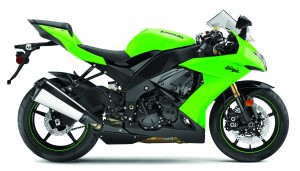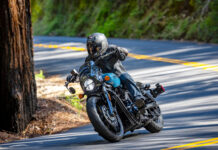If there’s one thing Kawasaki isn’t suffering from, it’s an identity crisis, especially in the sportbike segment. But that wasn’t always the case. A few years ago the bikes Kawasaki would take racing were more like street bikes disguised with racing numbers and slick tires. That changed in 2003 when the brand introduced the ZX-6R and ZX-6RR. From then on the company mantra has been simple: Create motorcycles that are track ready and just barely street legal. The following year Team Green introduced its first true liter-class superbike, the ZX-10R, incorporating the same track focus. If there were any doubts about Kawasaki’s stance on racing, the ZX-10R eliminated them. Though enormous power was always on tap, the bike was criticized for its ill handling when pushed to the limits. The following years would see the 10R get refinements, eventually leading to what we have here–the 2008 Kawasaki Ninja ZX-10R.
True to form, Kawasaki’s latest literbike has one intent: winning races. In fact, almost all of the development and testing for this bike was done on the racetrack. Only then was it taken out on the street and modified slightly to work on the road–basically meaning it was given lights and mirrors. The design team focused on five major points on this project: improving rider feedback, designing the ergonomics to be more track oriented, improving the bike’s nimbleness, giving it better throttle response and, of course, upping the horsepower.
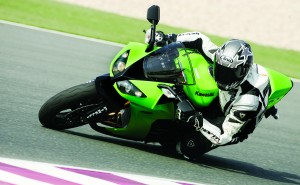
To improve rider feedback, the frame became more rigid. Though many of the changes aren’t visible to the naked eye, the most noticeable (when looking at cutaway frames) is a straightened ram-air passageway around the head pipe, increasing chassis strength and giving the air a more direct path to the throttle bodies. Another goal Kawasaki had in mind when designing the ergonomics of the 10R was to give the rider as much contact with the motorcycle as possible for “improved rider feel.” The gas tank, frame, seat and tail section were all redesigned, so whether you’re going straight or leaned over the bike is always talking to you. This probably sounds like a bunch of marketing mumbo-jumbo, but it works–read on.
Keeping the front tire on the ground is a fully adjustable 43mm male-slider fork with DLC (Diamond Like Coating) for reduced friction. In the rear sits a fully adjustable link-type shock, which adds adjustments for both high- and low-speed compression damping. This year radially mounted four-piston calipers with two pads (instead of four on last year’s model) clamp down on 310mm petal-type rotors.
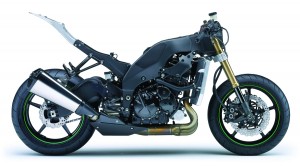
As if the engine needed any more power, the latest version now has reshaped and hand-finished combustion chambers for smooth airflow, secondary fuel injectors located above the oval throttle bodies for improved throttle response, titanium valves and camshaft profiles with higher lift. Kawasaki claims that, with ram air, this engine puts out 190 horsepower at the crank…all while meeting Euro III emissions standards! All this power is fed through a six-speed gearbox with an adjustable back-torque limiting clutch.
With so much power on tap, keeping it all under control was a major concern. The Kawasaki Ignition Management System hopes to quell any unwanted applications of the throttle. Take note: This system is not traction control, as there are no wheel speed sensors. Instead, every .02 seconds KIMS monitors a variety of parameters like engine speed, throttle position, gear position, intake air pressure and temperature to determine sudden spikes in engine speed. If a sudden surge is detected, the ignition timing is retarded to bring everything back in line. The system is passive in that, if you ham-fist the throttle open on corner exit, it will assume you want the full delivery of power. The system only comes alive in neutral or closed throttle applications. For instance, assuming the bike is leaned over on neutral throttle and the rear tire hits a patch of gravel, the tire will spin, resulting in a spike in engine speed, even though the rider never twisted his wrist. That’s when the KIMS steps in and settles everything down.
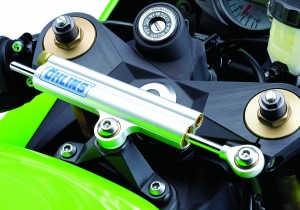
With all the techie stuff out of the way it was time to see if the big Ninja lived up to the hype. To do this, Kawasaki flew us to the Losail International Circuit in the small Persian Gulf state of Qatar to give these bikes a good flogging. Though the track was featureless except for the fake grass lining the edges, the pavement was smooth and provided good levels of grip. The technical track would also test the bike’s high- and low-speed handling capabilities. Fitted with Pirelli’s ultra-sticky Super Corsa tires (Bridgestone rubber is standard on bikes coming Stateside), we were let loose. Immediate first impressions revealed that the bike is fairly narrow and compact, with the rearsets actually lower than I expected. Make no mistake, this bike is fast, but power delivery is so smooth it’s deceiving. Until you look down at the speedo, that is. The big analog tachometer is easy to read, especially when the needle smacks the 13,000-rpm redline. The large LED display inside the tach holds the speedometer, gear indicator and, for the racer in all of us, a lap timer, among other things.
Back on track and the new ZX-10R continued to impress. Remember that bit about rider feedback and the bike’s ability to “talk” to you? Well, flicking the bike from side to side showed that it’s surprisingly nimble. Feel from both the front and rear suspension inspired the confidence to keep leaning the bike farther and farther. That is, until the pegs touch the ground. Coming around the final bend and accelerating down the mile-long straight the Ninja was a rocket. Clicking through the six-speed box was a breeze, except for a stubborn third-fourth gear change at times. The low windscreen channels air over the head while the turn indicators mounted on the mirrors actually divert air up and over the shoulders. While it may look weird, the indicators actually help envelope the pilot in a tight air pocket while in a tuck.
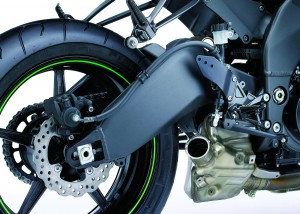
A quick peek at the speedo showed upward of 260 kph (we were riding Euro-spec models) before jumping on the binders for Turn 1. Lap after lap, the brakes slowed the 394-pound (claimed, dry) Ninja without a hint of fade. Initial bite was excellent and modulation was simple. With a little rebound damping taken out of the rear shock its tendency to get light under braking was reduced and made the bike almost feel like a 600 in the turns.
I know what you’re thinking–so how does the KIMS work? Honestly, I can’t tell you, since conditions on this track were nearly perfect. Although I can confirm that the system definitely is not a form of traction control, at least in the traditional sense. Exiting a sweeping 180-degree hairpin, with the bike still leaned over, yours truly was a little too greedy with the throttle. Remember, when the rider gives the bike throttle the KIMS doesn’t activate. As such, the small contact patch of the Pirelli was overwhelmed by my right hand and started to spin. Not wanting to get launched to the moon, a steady release of the throttle brought everything back in line. If it were true traction control, wheel speed sensors would have detected the wheelspin and brought it to a halt, despite the twisting of my wrist.
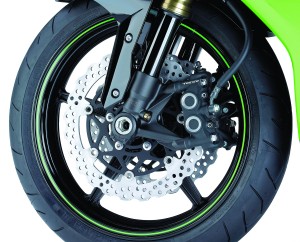
As great a motorcycle the ZX-10R proved to be, it has its limitations. As mentioned earlier, the footpegs were touching down sooner than expected. A shame considering how eager the bike is to lean. Though it is equipped with a steering damper (and an Ohlins at that), its effectiveness was questionable. Clicking through the different settings didn’t reveal any difference in stiffness, and some headshake on the track still meant lifting off the throttle at times. But take into consideration just how well the rest of the package works and it’s easy to overlook these minor issues. However you look at it, Team Green is coming out of the gates swinging for 2008 and the rest of the Big Four better look out–this Ninja will be hard to beat.
